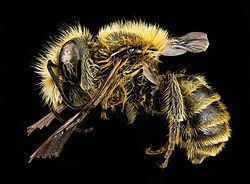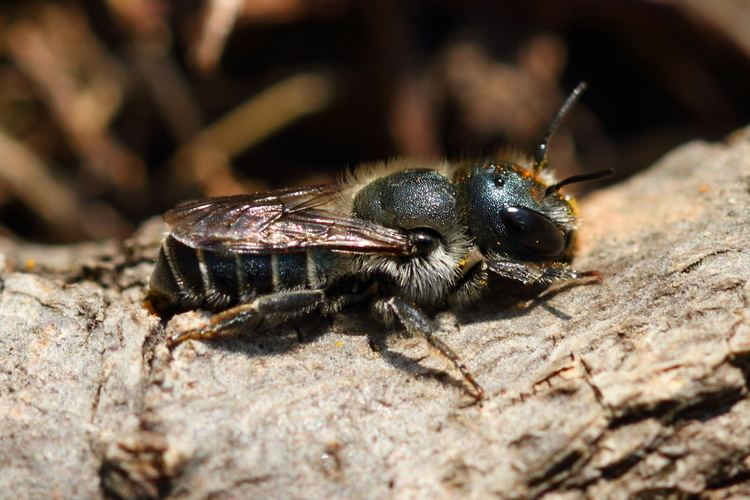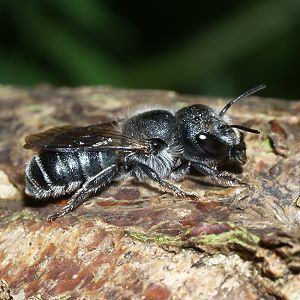Genus Mason bee Order Hymenopterans | Rank Species | |
 | ||
Similar Mason bee, Hymenopterans, Osmia bicolor, Megachile willughbiella, Heriades truncorum | ||
Osmia caerulescens, the blue mason bee, is a species of solitary bee from the family Megachilidae. It has a Holarctic distribution extending into the Indomalayan region, although its presence in the Nearctic may be due to human assisted introduction.
Contents

Description

Females Osmia caerulescens are 10–11 mm in length, they are dark blue-black bees with a metallic sheen, which are sparsely covered with brown hairs with those on the abdomen forming a narrow, dense, flattened band on the hind margin of each of the segments. The dense brush of pollen collecting scopae on the underside of the abdomen is jet black. The males are slightly smaller, 9mm, more slender in build, distinctly metallic green and clothed with pale hairs.
Habitat
Osmia caerulescens occurs in a wide variety of habitats, including woodland and private gardens.
Biology

Osmia caerulescens uses a variety of preexisting cavities for nesting in such as insect burrows in dead wood and drilled borings in wooden blocks; hollow stems, drilled borings in pithy stems or burrows created by other insects in the ground; insect burrows in the ground, abandoned cells in exposed nests of other aculeates, cavities in banks, holes and crevices in walls and glass tubes. The cell partitions and the nest plug are made of masticated leaf material and sometimes chewed petals are used as well. Any irregularities in the nest burrows are lined with leaf pulp. In larger cavities, the cells are irregularly arranged and the cell walls are partially or wholly built of chewed leaves.

The bees winter as diapausing adults in their intact cocoons. In Great Britain and France this bee is bivoltine and is partially so in the Netherlands The males usually emerge first and wait around the nests seeking females to mate with and are active for about three weeks. The two flight periods in Great Britain are from mid April or May to late July, and then again in August.

The bee is polylectic, but it collects pollen nearly exclusively on members of the Fabaceae. It has been observed collecting pollen from Coronilla, Hippocrepis, Lotus, Medicago, Melilotus, Onobrychis, Trifolium and Vicia. It has also been observed to collect pollen from some members of the Lamiaceae, Asteraceae, Brassicaceae, Hypericaceae and Ranunculaceae The scopae of the females are used to comb pollen from the nototribic anthers of Lamiaceae and Antirrhineae.

Occupied cocoons of the sapygid wasp Sapyga quinquepunctata have been recovered from a nest of Osmia caerulescens and the Natural History Museum, London has specimens of S. quinquepunctata which have been reared from the nests of O. caerulescens.
Subspecies
There are two recognised subspecies of Osmia caerulescens.
Distribution
Osmia caerulescens is mainly Palearctic and is found over most of Europe and Asia, the Middle East and North Africa. In Great Britain it is mainly found in England and Wales becoming more localised in the north and reaches central Scotland. It is also found in India. The occurrence of O.cearulescens in North America may be the result of introduction by humans. Its North American range is from Minnesota to Nova Scotia, south to Illinois and North Carolina.
